ABSTRACT
A mini-review is presented on handmade papers regarding their origin from papyrus to modern paper mill start-ups in the USA. The overview succinctly covers the process of making handmade papers, value addition, and product design. The scientific investigations on obtaining HMP from innovative raw materials such as coffee beans, agro-waste, seaweeds, hyacinth flowers, and others are detailed. The role of handmade paper in conservation along with the environmental and economic benefits of recycled handmade paper are contained within. The mini-review concludes with a promising future for handmade papers that would encourage sustainability.
摘要
本文对手工纸的起源进行了简要回顾,从莎草纸到美国的现代造纸厂初创企业. 概述简要介绍了制作手工纸的过程、增值和产品设计. 关于从咖啡豆、农业废弃物、海藻、风信子花等创新原料中获取HMP的科学研究进行了详细介绍. 手工纸在保护中的作用以及回收的手工纸的环境和经济效益都包含在内. 小型审查的结论是,手工纸的前景很好,这将鼓励可持续发展.
History of handmade paper
Once upon a time, in 3500 BCE, the pith of papyrus plants was utilized for producing thick, flat, paper-like material for writing. In 104 CE, the Eunuch Cai Lun at the Imperial Chinese Court of The Han Dynasty created paper from mulberry and bast fibers. The waste from hemp, old rags, and fishnets were incorporated (WildPaper handmade paper Citation2022). The Mayans made handmade paper from bark in 500 CE. In Europe, paper-making originated in Xativa, Spain, in 1151 CE. In 1680 CE, the Dutch implemented a Hollander beater to manufacture paper pulp from plant fibers. After that, in 1495 and 1690, the first paper mill was established in Europe and the United States of America (History of Paper Citation2022). Hence, the history of HMP is unique and with the potential of a Unique Selling Point (USP) for the future of HMP.
Handmade papermaking
The art of handmade paper (HMP) making is best explained by the pioneers in the field by a video provided in reference (Herve Citation2022) named A Day in Auroville papers. The Auroville Papers 1996 experiments and creates multitudes of beautiful HMP from surplus cotton rags, papers, papyrus, pineapple, and banana fibers. They produce a wide range of stationery, jewelry, and cotton Mache artworks with the HMP (Herve Citation2022). Likewise, the HMP-making process was studied wherein the stems of water hyacinth and vegetable peels from the kitchen bio-waste were utilized for making handmade paper, as depicted in . The bleached handmade paper acquired a brightness value of 37.2% and a tear and tensile index of 6.70 m. Nm2/g and 49.2 N m/g, respectively. Likewise, the compost made of 50% water hyacinth and 50% kitchen bio-waste solid was the best quality (Islam et al. Citation2021).
Figure 1. Production of compost and handmade paper from the seaweed water hyacinth (Islam et al. Citation2021).
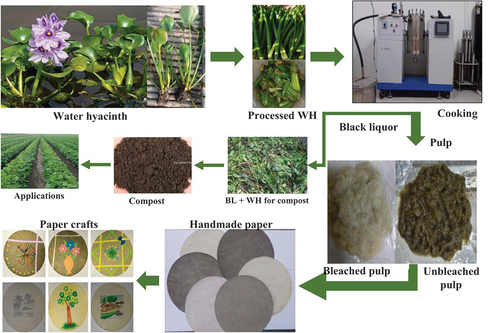
The HMP paper is a semi-manual cottage industry product. The method of HMP making could be purified further by minimizing water, energy, and fossil-based additives demand. For example, this could be achieved by installing a water recycling plant implemented by Auroville papers, in India (Herve Citation2022). Also, consumer awareness by preferring raw unbleached paper to bleached paper would impel sustainability. The HMP as conservation material is designed skillfully for preservation, repair, and bookbinding. These HMPs are structured to specific purity and strength that is unique and differs from the readily available acid-free paper for printing graphics. Some of the finest European and Oriental HMPs are employed with the intent of preservation and conservation (CXD International Citation2022). On the other hand, the conservation framer ensures that the work of art created with HMP remains stable and is preserved over an extended period. The goal is to protect it from environmental stimuli (Seery Citation2013). Paper Chemistry is at the heart of handmade paper conservation and requires it to be cultivated among the chemists of future generations (Hand Papermaking, Inc Citation2008). Hence, the HMP can be utilized as a conservation material and HMP artworks are required to be preserved. Also, the process of handmade paper-making ought to be simplified, and purified.
Innovation and technology
The handmade paper could be generated by recycling any paper, it could be made from tree-free (non-wood) raw materials as cited further in an eco-friendly manner. The elephant dung, corn husk, hemp, and linen fibers are successfully utilized to make HMP (Bluecat Paper Citation2020a). In the same vine, Areca nuts and cardboard paper were de-lignified by cooking in 5%, 10%, and 15% H2O2 at 80°C for 90,120, and 150 minutes. The optimum conditions were concluded to be belching with 15% H2O2 for 150 minutes (Dewi et al. Citation2020). The brightness level of the areca nut paper was directly proportional to the bleaching time acquiring a probability value of 0.0018. Likewise, the bleaching time was inversely proportional to the tensile strength in kN/m2, gaining the probability value of 0.0297. The brightness level and tensile strengths were 14.71% and 69.50 kN/m2, respectively, for a paper with a grammage of 282 gm/cm2, a thickness of 0.88 mm, and a water content of 6.5% (Dewi et al. Citation2020). The pulp of waste banana fibers was utilized for making handmade paper of 60 g/m2. Its drainage resistance was 71 °SR, the tensile index was 23.7 N.m/g, the burst index was 2.2 kPa.m2/g, and the tear index was 5.0 mN.m2/g. The kappa number was 29.9, with a pulp yield of 29.3% acquired on processing waste banana fibers with 12% NaOH for 150 minutes (Arafat et al. Citation2018). Stems of aquatic plants, namely Cyperus digitatus, Cyperus halpan, Cyperus rotundas, Scirpus grosses, and Typha angustifolia were studied for handmade paper making on varied parameters with the other non-wood and aquatic plants from Musa paradisiaca, Bambusa tulda, Saccharum sp., Arundo donax, and others. The results are summarized in . Due to the Cellulose content of Cyperus rotundus (42.58 ± 1.32%), Scirpus grossus (36.21 ± 2.81%), and Typha angustifolia (44.05 ± 0.49%) >34%, these seaweed plants were inferred as appropriate for pulp and papermaking units (Bidin et al. Citation2015).
Table 1. The study results on the physical properties of HMP from seaweed fibers and traditional fibers (Bidin et al. Citation2015).
Interestingly, the HMP was constituted from the waste office papers and PPE kits in ten varied proportions and evaluated for hardness, moisture content, and photometry analysis. As hypothesized, increased PPE content was inversely proportional to the moisture content and directly proportional to the hardness gained of HMP and accordingly would be the end-user. The HMP with 50% PPE waste and 50% office paper exhibited high photometric values (Kumar et al. Citation2021). Aguilar-Rivera and team suggest HMP from the cellulosic coffee pulp as displayed in , denoting 25% coffee pulp with 75% other waste fibers and papers and 2b indicating 50% coffee pulp paper with 50% other waste fibers and papers (Aguilar-Rivera et al. Citation2014). Agro-residues such as wheat and rice straw were investigated and concluded to be the cost-effective non-wood raw material for making HMP. The maximum fiber length was reported to be 3.84 mm and 2.7 mm for wheat and rice straw correspondingly (Chauhan, Agarwal, and Khan Citation2015). Likewise, agricultural waste from banana fibers and sugarcane bagasse was experimented with for making HMP. It was noted that the bagasse paper with 2% calcium carbonate and 2% starch added to it gained the highest values for GSM of 108, pH of 7.29, and thickness of 0.25. Whereas its equivalent banana fibers obtained the highest amounts of the bulk of 640 and moisture content of 66.67. The agro-waste served as a fruitful raw material for manufacturing HMP (Khalsa and Dwivedi Citation2017). Additionally, Sottile et al., extracted cellulose materials from the fresh Opuntia ficus indica cladodes (prickly pears) and obtained a slurry with hot water treatment for making HMP (Sottile et al. Citation2021).
Figure 2. HMP from coffee pulp fibers 2a. Denoting 25% coffee pulp with 75% other waste fibers and papers and 2b. indicating 50% coffee pulp paper with 50% other waste fibers and papers (Aguilar-Rivera et al. Citation2014).
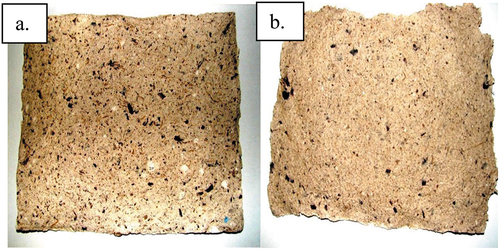
Traditional, Hanji, Korean handmade paper, 309 in number was studied and observed to demonstrate color value ranges of L* (69.9–95.9), a* [(− 3)-3], and b* (0–20). The pH was noted to be from 5.3 to 9.8. Much of the Hanji HMP had a grammage in the range of 100–150 g/m2 and a thickness in-between 100–150 µm. The HMP sheets were formed by two techniques: Heullimtteugi (criss-cross fiber orientation) and Gadumtteugi (on-grain fiber alignment). The tensile strength of on-grain fibers paper was in the range of 352.8–3000 N/min, which was higher than 183.1–2000 N/m for criss-cross fibers paper. The folding endurance of 60% of the Hanji papers was in-between 1.2 and 500 times. The Korean handmade papers called Hanji paper are made of fibers from the barks of mulberry, gampi, and mutsumata. The Gas Chromatography-Mass Spectroscopy analysis identified cellulose as the primary content in Hanji paper besides lignin monomers and terpenic compounds (Han et al. Citation2021). The traditional Chinese paper Xuan was studied for photo yellowing of the paper with UVA photolysis. A significant yellowing of paper occurred when irradiated in the dry state compared to the wet state. The HMP demonstrated auto-fluorescence in the blue spectral range (450–500 nm). As illustrated in , the morphological study on SEM indicated that the Xuan HMP is made with rice straw fibers and blue sandalwood fibers (Tang and Smith Citation2013).
Figure 3. Scanning Electron Microscope image of the Xuan HMP wherein “B” indicates Blue sandalwood fibers and “R” denotes Rice straw fibers (Tang and Smith Citation2013).
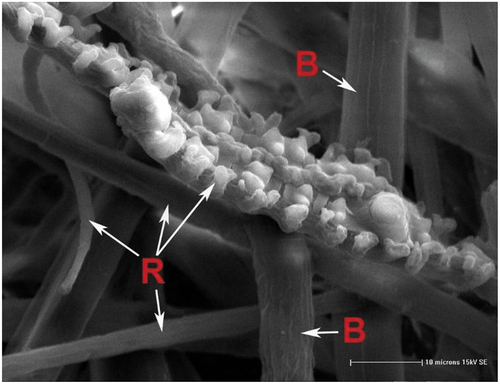
Overall, the research development on HMP is focused on identifying and utilizing alternative sources of natural fibers such as coffee pulp, seaweed, and areca nut plants for making HMP. Generating the best out-of-waste office papers and cardboard cartoons for developing HMP. The need for significant research and development in HMP is identified to achieve greater benefits. Innovation in HMP needs a breakthrough in varied aspects such as novel raw material sourcing, refined processing, and diversified product development Additionally, it calls for exclusive packaging, branding, and marketing strategies to be developed for promulgating HMP.
Product design and value generation
Product development and value addition are significant aspects of designing HMP. For example, a few of the HMP product innovations by Auroville papers are displayed in , demonstrating the development from cotton rags to HMP flowers, jewelry, and stationery.
Figure 4. Auroville Papers, product development and value addition with HMP a. Cotton rags as major raw materials for HMP making b. Fairy cups flowers with cotton rags HMP b. HMP Necklace and d. HMP Stationery with leaf imprints (Herve Citation2022).
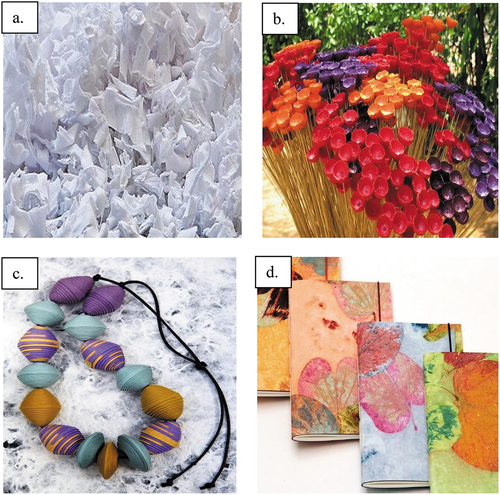
The Daqian handmade paper with a grammage of 25.46 g/m2 and thickness of 94 μm was value-added through coloration with plant-based materials from the gardenia, pagoda bud, turmeric, and Amur cork tree. All the materials yielded yellow-colored handmade paper; the maximum b* a value of 57.5 was obtained with a Gardenia extract solution of pH 4.51. The tensile strength values and folding endurance of the dyed papers were enhanced via post-coloration, as depicted in . The pH of the colored handmade papers was in the acidic range of 6.02 to 6.98 (Luo and Xiujuan Citation2021).
Figure 5. Handmade paper a. Tensile strength and b. Folding endurance post-coloration with plant-based materials (Luo and Xiujuan Citation2021).
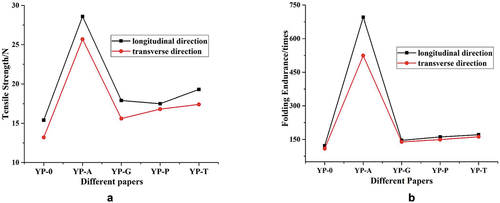
In the same vein, Saakshy et al. reviewed handmade paper. They suggested that the HMP made in India should utilize natural colors from Terminalia arjuna, Terminalia chebula, Quercus infectoria Acacia catechu, and others due to the life-threatening carcinogenicity of azo group-containing and benzidine-based dyes. This is essential to prevent the decline in export demand for HMP to the countries such as Germany, the UK, and the USA due to legal rules (Azo-ban) applied by the respective countries (Saakshy, Sharma and Jain Citation2013). Additionally, a project on HMP conducted by Menon et al. concluded that HMP could play a vital role in women’s empowerment and promulgating handmade eco-friendly products from HMP; for example, paper bags would enable curtailing our dependency on plastic bags. Establishing HMP units would encourage entrepreneurship and skilled craftsmanship, especially in rural India. In this way, it would contribute toward value generation and self-sustainability (Menon et al. Citation2020).
Interestingly an ancient “Echizen Washi” Japanese HMP was studied regarding ergonomics in relevance to skilled craftsmanship and handling large-formatted Japanese HMP. A pair of mother and daughter were selected for the study, as depicted in . The following steps were involved.
Figure 6. Japanese HMP is making progress for the ergonomics study (Kawamori et al. Citation2020).
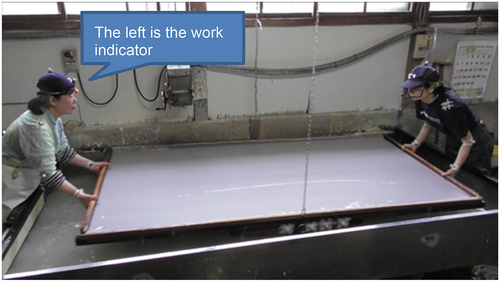
Kumiage,
Sunagashi,
Suki,
Sukibune, and
Sukisu.
The method called Sukisu in combination with the Skigeta collective known as Sugeta was sequentially performed. It was noted that the craftsmanship improved with work experience in making waste-free and quality Echizen Washi HMP (Kawamori et al. Citation2020), thereby affecting productivity and profitability.
The concepts for merging HMP with plant-based colors such as turmeric, manjistha, others and value-added materials, namely leaf imprints, and jute rouching techniques, would further propel the sustainability aspect of HMP. HMP is beautiful and luxurious. The artists, designers, and consumer awareness could benefit the cottage industry to survive and prosper economically. Thus, globally the HMP production and market are at a niche level. To propel its market new sustainable products need to be designed and developed.
Eco-friendly handmade paper
Handmade paper making is a manual process in contrast to the industrial handling of mill-made paper. The HMP making is elaborate, obtaining one paper at a time with natural variations and unique traits. The machine-made paper yield is the large, continuous, and consistent quality of paper acquired (Bluecat Paper Citation2018b). The worldwide production of paper was 407 million metric tons in 2015 and was predicted to reach 500 million metric tons by 2020 (Bajpai Citation2018). More than 15 million Christmas trees are uprooted for manufacturing papers for gift wrapping. One kilogram of paper generated three and a half kilograms of carbon dioxide. It consumes one and a half kilograms of coal as fuel during production (Our Endangered World Citation2021). Tree-free handmade papers offer a sustainable answer to resolve the environmental crisis arising due to mill-made paper (Mathew Citation2020). The tree-free papers could be constituted from the bagasse. Bagasse is a sugarcane waste collected after juice extraction. It is high in cellulose which is 45% and therefore suitable for making HMPs and others. Similarly, the HMPs could be developed from bamboo and kenaf plants (Mathew Citation2020). Alternatively, calcium carbonate bonded with a small amount of high-density polyethylene resin generated limestone paper. Limestone paper is not biodegradable however it is photo-degradable, compostable, and recyclable (Mathew Citation2020). The handmade paper is 100% recycled non-wood paper. HMP production consumes 50% less energy and 75% less water than machine-made paper. It generated 90% fewer water effluents and 70% fewer air emissions (Bluecat Paper Citation2018a).
In summary, HMP making is a skilled art promulgating HMP promotes the survival of both the art and artists. The regional local people involved in making HMP are supported hence, sustainable (Goswami Citation2021). The paper could be recycled up to six times. Recycling one ton of paper protects 17 trees, 7,000 gallons of water, and 380 gallons of oil (West Citation2020). It conserves 3.3 cubic yards of landfill space and 4,000 kilowatts of energy. These savings could provide six months of power supply to the average U.S. home. Additionally, it prevents greenhouse gas emissions by one metric ton of carbon equivalent (West Citation2020).
Miscellaneous
The handmade paper and wheat straw waste sludge were utilized as a substrate to cultivate the Pleurotus citrinopileatus variety of golden oyster mushrooms. The mushrooms gained had biological efficiency of 88.9%. The moisture, protein, fat, ash, and carbohydrate content were 93.73%, 14.48 g/100 g, 0.17 g/100 g, 0.29 g/100 g, and 2.60 g/100 g, respectively. The carpophores cultivated on the handmade paper and wheat straw exhibited no base pair mutations and safe levels of frameshift mutagens hence suitable for consumption. Conclusively, it would enable fruitful utilization of waste sludge and thereby protect the environment (Kulshreshthaa et al. Citation2013). Waste from the juice center of the apple, pineapple, banana, and orange was utilized to isolate fungi by the Sabouraud dextrose agar (SDA) method in which the plates were incubated for 7 days at 28 ± 2EC. The five fungal isolates, namely, Alternaria sp., A. niger, Cladosporium sp. and Penicillium sp. under acidic conditions and Alternaria sp., A. niger, Helminthosporium sp., Penicillium sp., under alkaline conditions were identified to be potent for handmade paper industry for cellulase production by submerged fermentation. The czapk dox broth at 28 ± 2EC, pH of 5.0 with 2 days of incubation in the submerged fermentation process was concluded to be ideal (Singh, Sharma, and Gupta Citation2018). Innovative end uses and out-of-the-box applications of HMP could be studied before long. Similarly, the Seed paper is the HMPs that could be made from cotton rags, elephant poo, flax, mulberry, and others (Bluecat Paper Citation2020b). The seeds of flowers such as marigold, begonia, and vegetables such as tomatoes, carrots, and basil are embedded in the seed paper. The fruits and vegetables cultivate further by implanting the seed paper in fertile soil. The paper decomposes naturally hence, sustainable (Bluecat Paper Citation2020b).
Conclusion
To summarize, traditional paper-making faced a decline in mass production and profitability. However, with investigations with varied alternative natural materials for pulp making, product designing, and sustainability at the forefront, the handmade paper-making market has gained great momentum and a prospective future. Interestingly the Jinjiang HMP makers suggest associating traditional handmade paper making with travel and tourism as a symbol of cultural heritage to maintain its vitality (CGTN Citation2022). Overall, the following conclusions could be made from the review.
The study cited several novel sources of raw materials for obtaining handmade paper such as sugarcane bagasse, wheat, and rice straw, prickly pear, and others.
The significant technical information regarding the HMP grammage, thickness, tensile strength, moisture content, pH, and others influencing the quality of HMP obtained were studied.
The novel and beautiful product development with HMP was covered.
The economic and environmental benefits of HMP were summarized in the review paper.
On critical analysis, it was realized that there needs to be a significant breakthrough in the research and development of HMP. Parallelly, there are gaps noted in the form of insufficient product development and marketing strategies to connect HMP globally. Nonetheless, it is imperative to purify the handmade papermaking process for enhanced sustainable outcomes.
Highlights
The paper covers the scientific and technical aspects of HMP making, and the essential properties of HMP are discussed.
The overview supports that Handmade paper encompasses the immense potential to propel sustainability.
The world of HMP is unique; extraordinary, beautiful, and functional products are created with HMP as explained by images.
Finally, the mini-review concludes a potentially bright future for HMP that requires to be focussed and strengthened.
Future work
The mini-review summarizes handmade paper making and products from past to present. The study suggests promulgating and investigating the value generation and sustainability aspect of the HMP. This could be achieved by investing in HMP cottage industries and performing a life cycle analysis of the HMP. The surplus natural raw materials, fibers, and papers combined with plant-based colors and subsequent eco-friendly finishing and packaging would propel sustainable HMP, therefore recommended for future research and development. An ecological, creative, and self-sufficient HMP cottage industry is envisioned for the future.
Disclosure statement
No potential conflict of interest was reported by the authors.
References
- Aguilar-Rivera, N., E. Houbron, E. Rustrian, and L. R. Alvarado. 2014. Amate paper in the pulp of coffee (Coffea arabica). Ra Ximhai 10 (3):103–10. doi:10.35197/rx.10.01.e.2014.08.na.
- Arafat, K. M., J. Nayeem, A. H. Quadery, M. A. Quaiyyum, and M. S. Jahan. 2018. Handmade paper from waste banana fibre. Bangladesh Journal of Scientific and Industrial Research 53 (2):83–88. doi:10.3329/bjsir.v53i2.36668.
- Bajpai, P. 2018, June 26. Challenges and opportunities for the pulp and paper industry. Retrieved from 06 03, 2022. https://scitechconnect.elsevier.com/challenges-and-opportunities-for-the-pulp-and-paper/
- Bidin, N., M. H. Zakaria, S. J. Bujang, and N. A. Aziz. 2015. Suitability of aquatic plant fibres for handmade papermaking. International Journal of Polymer Science 2015:1–9. doi:10.1155/2015/165868.
- Bluecat Paper. 2018a, July 17. Environmental benefits of choosing handmade paper. Retrieved 06 03, 2022, from https://bluecatpaper.com/environmental-benefits-of-choosing-handmade-paper/
- Bluecat Paper. 2018b, July 17. Handmade paper vs machine-made paper. Retrieved 06 03, 2022, from https://bluecatpaper.com/handmade-vs-machine-made-papers/
- Bluecat Paper. 2020a. Elephant poo paper. Retrieved 6 03, 2022, from https://bluecatpaper.com/elephant-poo-paper
- Bluecat Paper. 2020b. Seed paper. Retrieved 6 03, 2022, from https://bluecatpaper.com/seed-paper
- CGTN. 2022, 02, 28. Small-town Stories: Jiajiang, home of Chinese hand-made paper. Retrieved from https://www.cgtn.com/:https://news.cgtn.com/news/2022-02-28/Small-town-Stories-Jiajiang-home-of-Chinese-hand-made-paper–181ur6KHInS/index.html
- Chauhan, S., S. Agarwal, and M. E. Khan. 2015. Prospects of agro-residues like wheat straw and rice straw in handmade paper. Handmade Paper & Products Souvenir 73–78.
- CXD International. 2022. Conservation paper & materials. Retrieved 6 03, 2022, from https://www.cxdinternational.com/paper-materials-range
- Dewi, I. A., S. Wijana, D. E. Royyani, P. Deoranto, A. Ihwah, M. S. Romas, and H. Setyawan. 2020. Optimisation of bleaching time and H2O2 concentration of handmade paper from Areca catechu L. fibre. International Conference on Green Agro-industry and Bioeconomy (p. 475). IOP Publishing. doi:10.1088/1755-1315/475/1/012090
- Goswami, T. 2021. Choose Handmade - Why buying handmade is better. Handmade is sustainable. Retrieved 6 03, 2022, from https://blog.folksy.com/2011/07/14/buying-handmade
- Han, B., L. B. Vilmont, H. -J. Kim, B. Lavédrine, S. Sakamoto, and M. Sablier. 2021. Characterization of Korean handmade papers collected in a Hanji reference book. Heritage Science 9 (1). doi:10.1186/s40494-021-00570-9.
- Hand Papermaking, Inc. 2008. Conservation framing of Handmade paper artworks. Retrieved 6 03, 2022, from https://www.handpapermaking.org/magazine-articles/conservation-framing-of-handmade-paper-artworks
- Herve, L. J. 2022, 03 13. A Day in Auroville Papers. Retrieved from https://www.aurovillepapers.com/:https://www.youtube.com/watch?v=qqW332od3KA
- History of Paper. 2022, 02 28. History of Paper. Retrieved from www.historyofpaper.net:http://www.historyofpaper.net/paper-history/timeline-of-paper
- Islam, M., F. Rahman, S. A. Papri, M. Faruk, A. K. Das, N. Adhikary, and M. Ahsan. 2021. Water hyacinth (Eichhornia crassipes (Mart.) Solms.) as an alternative raw material for the production of bio-compost and handmade paper. Journal of Environmental Management 294:113036. doi:10.1016/j.jenvman.2021.113036.
- Kawamori, Y., H. Nkagawa, A. Goto, H. Hamada, K. Yamashiro, N. Sugiyama, and Y. Yamada. 2020. Motion analysis of manufacturing of large “Echizen Washi” Japanese traditional paper. Advances in Manufacturing, Production Management, and Process Control. AHFE 2019. Advances in Intelligent Systems and Computing. 971, pp. 174–87. International Conference on Applied Human Factors and Ergonomics. 10.1007/978-3-030-20494-5_16
- Khalsa, A. S., and P. B. Dwivedi. 2017. Production of Handmade papers from sugarcane bagasse and banana fibres in Oman. International Journal of Students’ Research in Technology & Management 5 (3):16–20. doi:10.18510/ijsrtm.2017.534.
- Kulshreshthaa, S., N. Mathur, P. Bhatnagar, and S. Kulshreshtha. 2013. Cultivation of Pleurotus citrinopileatus on handmade paper and cardboard industrial wastes. Industrial Crops and Products 41:340–46. doi:10.1016/j.indcrop.2012.04.053.
- Kumar, V., S. Gupta, J. S. Kalra, and P. P. Patil. 2021. Improvement in the quality of handmade paper materials by recycling waste papers and PPE kits. Materials Today: Proceedings 46 (20):11274–78. doi:10.1016/j.matpr.2021.03.487.
- Luo, Y., and Z. Xiujuan. 2021. Effects of yellow natural dyes on handmade Daqian paper. Heritage Science 9 (1):1–10. doi:10.1186/s40494-021-00560-x.
- Mathew, A. A. 2020, September 13. Here are 5 sustainable alternatives to tree-based paper to reduce deforestation. Retrieved 06 03, 2022, from https://yourstory.com/socialstory/2020/09/sustainable-alternatives-eco-friendly-paper/amp
- Menon, A. R., A. Gopalakrishnan, A. G. Anjaly, and Rijo. 2020. Innovative solutions and technological interventions for employment generation and sustainable livelihood in Kerala, through handmade paper production and its value addition. International Journal of Applied Agricultural Research 15 (2):101–08.
- Our Endangered World. 2021, December 26. 12 Best Eco-Friendly Wrapping Paper Options. Retrieved 06 03, 2022, from https://www.ourendangeredworld.com/eco/eco-friendly-wrapping-paper/
- Seery, M. 2013, March 1. Paper conservation. Retrieved 06 03, 2022 from https://edu.rsc.org/feature/paper-conservation/2020204.article
- Sharma, S., and R. K. Jain. 2013. Application of natural dyes: An emerging environment-friendly solution to the handmade paper industry. Biotechnology for Environmental Management and Resource Recovery 279–88. doi:10.1007/978-81-322-0876-1_15.
- Singh, S. M., V. Sharma, and S. Gupta. 2018. In vitro optimisation of fungal cellulase production from fruit waste for handmade paper industries. Biotechnology 17 (1):35–43. doi:10.3923/biotech.2018.35.43.
- Sottile, F., A. Modica, S. Rosselli, A. C. Catania, G. Cavallaro, G. Lazzara, and M. Bruno. 2021. The hand-made paper was obtained by the green procedure of cladode waste of opuntia ficus Indica (L.) Mill. from Sicily. Natural Product Research 35 (3):359–68. doi:10.1080/14786419.2019.1631820.
- Tang, Y., and G. J. Smith. 2013. Fluorescence and photodegradation of Xuan paper: The photostability of traditional Chinese handmade paper. Journal of Cultural Heritage 14 (6):464–70. doi:10.1016/j.culher.2012.11.002.
- West, L. 2020, December 23. What are the benefits of paper recycling? Retrieved 06 03, 2022, from https://www.treehugger.com/the-benefits-of-paper-recycling-1204139
- WildPaper handmade paper. 2022, 01 13. Paper History. Retrieved from wildpaper.co.uk: http://wildpaper.co.uk/html/paper_history.html
